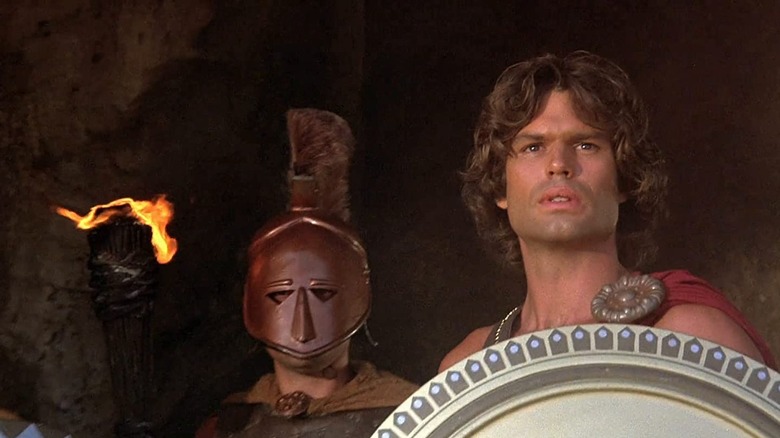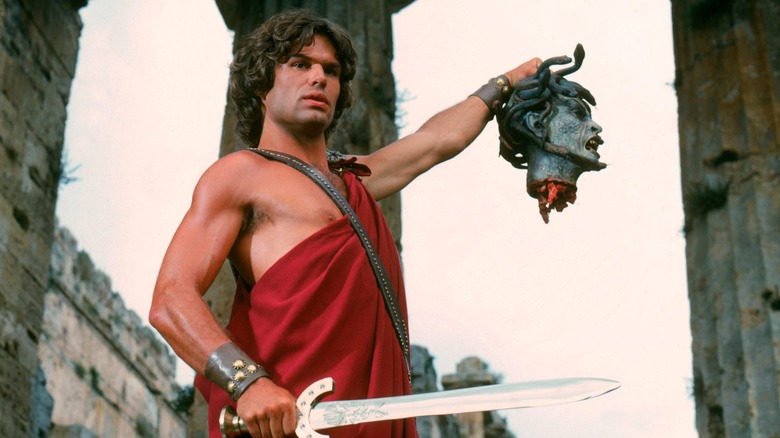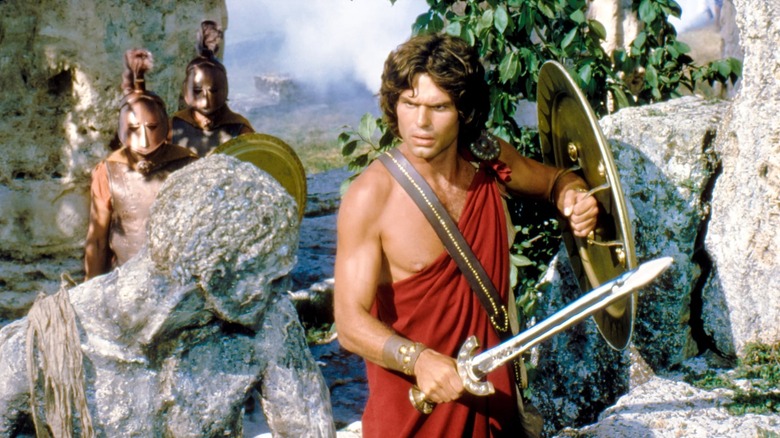Harry Hamlin Resolved A Clash Of The Titans Struggle By Locking Himself In His Trailer
Desmond Davis' 1981 fantasy film "Clash of the Titans" is a special effect extravaganza for the ages. Many of the film's creatures — Medusa, a Kraken, an evil satyr, and a mechanical owl named Bubo — were realized via some amazing stop-motion animation provided by SFX legend Ray Harryhausen. The bold, fantastical imagery matches the broad, archetypal story about the brave human hero Perseus (Harry Hamlin), and his role in a godly conflict involving Zeus (Laurence Olivier), the bitter Calibos (Neil McCarthy), and his bride-to-be Andromeda (Judi Bowker). The film at large is a little corny, but, like 1977's "Star Wars" or "Raiders of the Lost Ark" from the same year, "Clash of the Titans" takes something mythic and turns it into a slick, enjoyable Saturday matinee entertainment.
Prior to "Clash of the Titans," Hamlin had appeared in only one feature film, a diptych comedy called "Movie Movie," directed by Stanley Donen. The following year, Hamlin would court mild scandal by appearing in the queer romance "Making Love" (queer romances being a studio rarity in the early 1980s). It wouldn't be until later that Hamlin would achieve superstar status for his performance on the hit legal series "L.A. Law." He was always possessed of a movie star charisma, not to mention a pronounced chin and matinee idol good looks. Perseus was the kind of role constructed for a performer like Hamlin.
In a recent video interview with the AV Club, Hamlin revealed that the heroism of Perseus — at least in the way the ancient hero handled weapons — was something he had to fight to retain. A studio note, it seems, would have turned him into — in an embarrassing way — Captain America.
The frisbee shield
A notable sequence in "Clash of the Titans" featured Perseus and his men having to raid the cave-like lair of the gorgon Medusa. Medusa, to remind readers, turns interlopers into stone with her magical gaze. Perseus requires her head, then, as a weapon to be used against the undersea behemoth, the Kraken. Perseus had been blessed with a magic sword that was capable of taking off her head, and the inside of his shield was mirrored, allowing him to approach Medusa without looking at her. However, someone at United Artists became skittish about the violence in the movie, because there was to be a last-minute change, forcing Perseus to take off Medusa's head with a thrown shield instead of his sword. As Harry Hamlin said:
"Perseus, a lot happened on Perseus, that people don't really know about. They came to me one day, three-quarters of the way through filming the movie, and they said, 'You can't cut Medusa's head off with the sword.' Now, the whole reason I had the sword was to cut Medusa's head off. Zeus, Laurence Olivier, had given me the sword to cut her head off [...] You can't ... cut her head off with the sword, because in a telex they had gotten the night before it was determined that if I cut Medusa's head off with a sword and they get an X rating for violence.
In 1981, it should be remembered, there were only G, PG, R, and X ratings. "Clash of the Titans," an English/American co-production, came at a time of increased sensitivity to violence found in the British home video market — regulations on VHS content weren't as stringent as theatrical content — and the notorious 1983 list of "Video Nasties."
Violence in a fantasy context
"Clash of the Titans" certainly contains violence and death, but it is largely of the fantastical variety. The ancient weapons are used in bloodless battles with monsters, so there is not much in the way of human viscera. A decapitation, however, was a little too far for the censors, and with an X rating, Harry Hamlin said, "all the kids in England wouldn't be able to see the movie."
The studio solution was a little dumb. They wanted a half-accidental killing with something that wasn't a sword. Hamlin recalls the proposed kill, and how stupid an idea it was. He said that he was to throw his shield, whizzing it through the air:
"[I]nadvertently, like a frisbee ... bounce off the wall and cut her head off.'That's great, right?' Not."
Although Hamlin wasn't quite yet a household name, he still understood that he had some clout as the leading man of a major studio picture. Perhaps risky, Hamlin went into his trailer under protest and locked himself in. He refused to come out until the Captain America sequence was removed, and the initial sword slaying was reinstated. He doesn't reveal how long he remained under self-imposed trailer arrest, but he won out in the end. He said:
"They sent in all these people every 15 minutes to try to convince me to come out and shoot the scene. And every time they came in I was able to convince them that I was right and that the producers were wrong. And finally, at the end of the day, I won."
The final scene works just fine and makes sense from a screenwriting standpoint. Studio fretting was for naught, and the film was released with a PG rating. It was an enormous hit.


